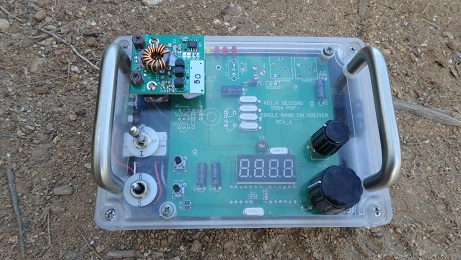Back in 2017 Steve KD1JV announced the first of the Soda Pop rigs. The Soda Pop is single band transceiver but was capable of operating of a wide frequency range. So, following some discussion on the forum Steve include extra pads to allow for the use of band modules should any one like to go down that path.
Naturally I was interested, but a single band rig for sota and parks is limiting, and I always preferred the pick your band option of the early ATS3 series rigs.
Fortunately Camel PD7LOL and David VK3IL took up the challenge and after some detailed work came up with a multi band rig (160-10) that used a plug-in band module. You can seed David’s post here, https://vk3il.net/projects/multi-banding-the-kd1jv-soda-pop/
Whilst I started the build in 2018 it took until 2021 to finish it off. Primary life got in the way, a difficult fault to track down and the challenges around enclosures for the rig.
The finished radio has three power options,
Internally, 2 to 4 CR123 or 2 x 18650 this combination was selected to allow easy field replacement / purchase. These batteries drive a Dc-Dc boost regulator to make 10volts to run the radio.
Externally, a USB C socket allows the radio to run from a bog standard USB battery bank capable of running at 2A. This input also feeds the Dc-Dc Boost to make 10v to run the radio
And also a good old 2.1mm socket that will power the radio direct.
Voltage monitoring is supported by the DC Beeper from Jackson. http://www.wb9kzy.com/ham.htm
I have used the modified version I covered in my post here. A momentary switch ether selects the “Input” or “Radio” voltage and reports the value in morse via a separate Piezo element.
A small speaker was added to allow listening without the use of headphones. The enclosure size limited options here so the volume is not loud but does allow simple monitoring. A 25mm cupboard vent from the local hardware provides the speaker grill.

I was keen to keep the final package a packable as possible, hence the handles on the front to protect the knobs and the use of a recessed RCA for the antenna. The RCA is slightly smaller and more rounded than the BNC and still suitable for the qrp rig.
SWR indication is provide by the 4 LED’s just above the pcb. This is the Tiny SWR board https://github.com/mfhepp/tinyswr and available as a kit from Ham Shop CZ https://www.hamshop.cz/
Inside the Rig;
A – VSWR PCB
B – DC Beeper PCB
C – DC-DC pcb ( Pololu S18V20AHV )
E – Two 18650 battery holders. This allows me to run 2 CR123’s (as in pic) or 2×18650 or even 4xCR123. Switching is achieved by the red ‘JST’ plug/socket just above battery holder. The 1A fuse provides a manual reset protection for the Li-ion cells
F – Small speaker hidden behind its baffle.
The rig works great, whilst not as compact as some of my SOTA rigs, it is a flexible radio making it a great Parks or travel rig with its flexible power and band choices.








Great result Warren, you have everything you need in a very versatile single box. The design choices are obviously informed by your extensive activation experience. The DC beep and swr modules are good finds. Little details like the tilting feet make it as useable as the ‘big rigs’. Hope to work you on it soon.
73 Paul VK3HN.
Thanks Paul, I do believe the rigs need to be usable and certainly with products like the Tiny SWR and DC Beeper it becomes easy to feature up a home build. The finished build is bigger than my sota rigs, but for parks it is quite comparable to the KX2. If required, the ATU would be external but I don’t see that as an issue. It has always been my preference to use an external ATU to move the “radiating element” away from the operator. Plus with such a wide frequency range and corresponding large choice of antenna types having an external ATU allows me to select which ATU I feel best suited for the job (generally either a Z match or L type)